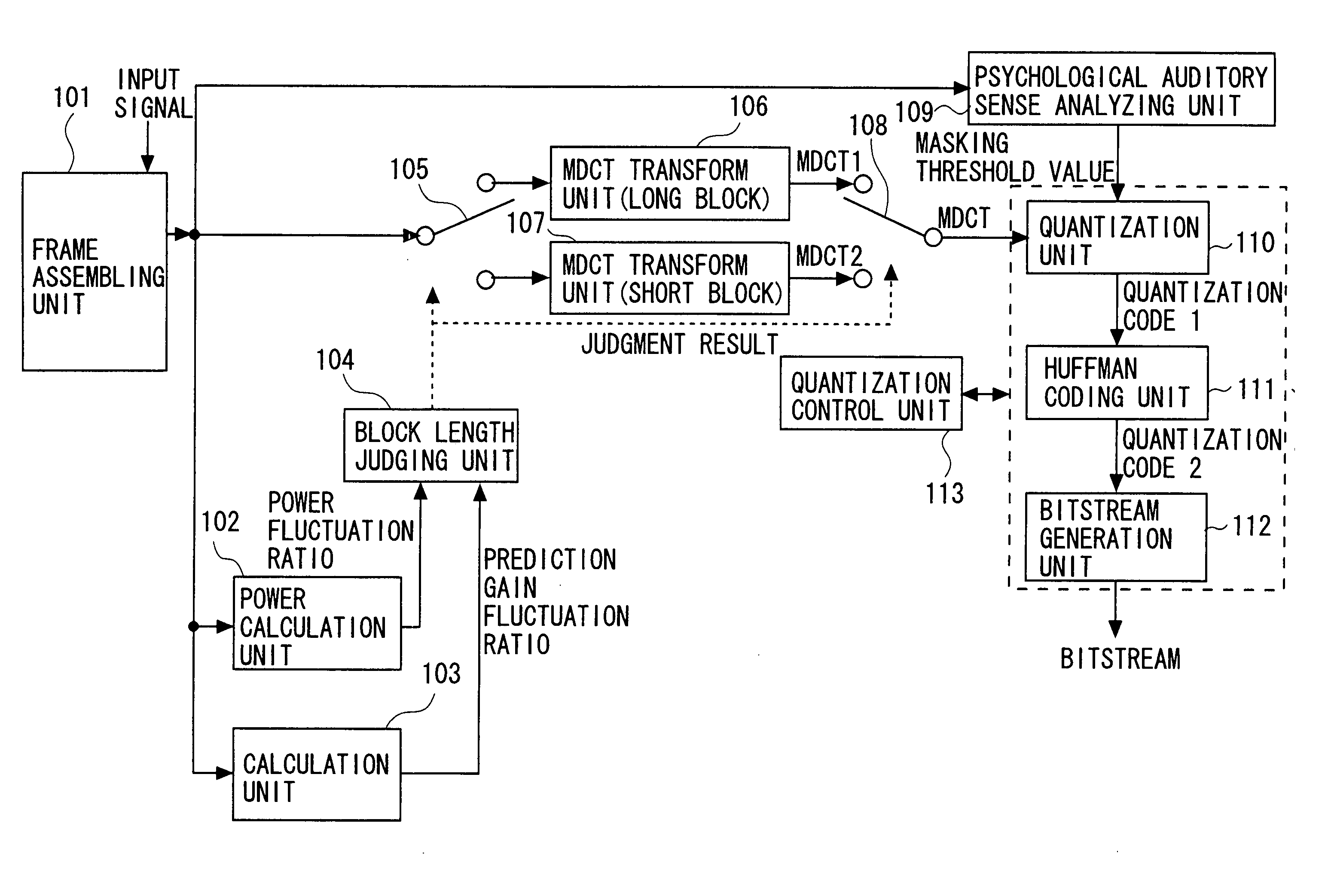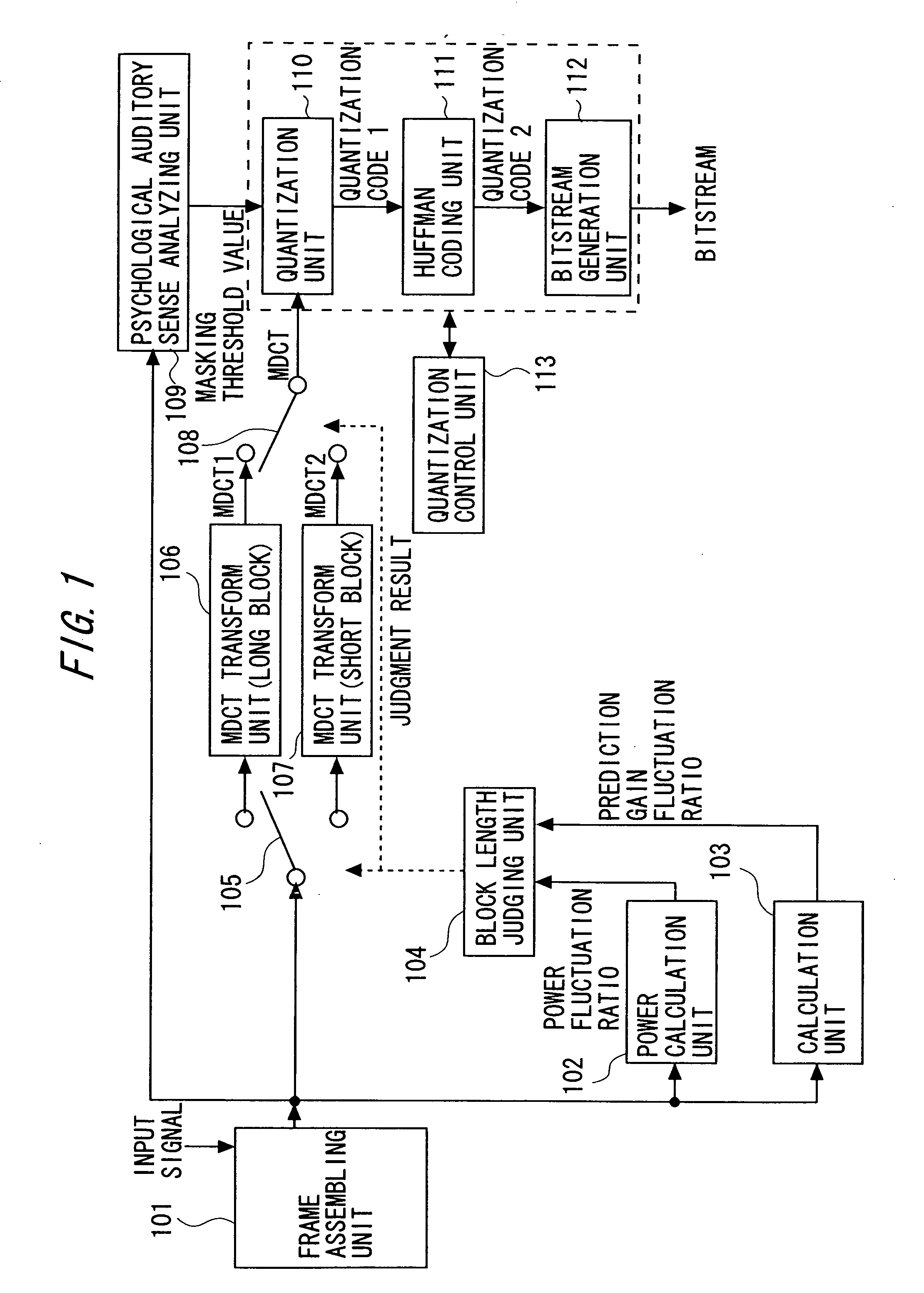Audio encoding apparatus and audio encoding method
a technology of audio encoding and audio signal, which is applied in the field of audio encoding apparatus and audio encoding method of encoding an audio signal, can solve the problems of inability to detect the change in the property of the input signal, the judgment of improperness, and the first prior art requires a large throughput, so as to reduce the decline of the sound quality, reduce the throughput, and reduce the effect of the sound quality
- Summary
- Abstract
- Description
- Claims
- Application Information
AI Technical Summary
Benefits of technology
Problems solved by technology
Method used
Image
Examples
first embodiment
[0184]FIG. 4 is a diagram of a configuration in a first embodiment of the audio encoding apparatus of the present invention. In FIG. 4, a frame assembling unit 401 segments inputted signals into input signal frames (long blocks) each consisting of a predetermined sample count.
[0185] Next, an MDCT transform unit 410 for the short block, a power calculation unit 402 and an auto-correlation calculation unit 403 segment an inputted single frame into short blocks. The frame segmentation in the first embodiment will be explained with reference to FIG. 2 given above. FIG. 2 is the conceptual diagram showing the example of the long block and the short block. In the example depicted in FIG. 2, one frame (long block) is segmented into four short blocks. The following discussion will be made based on this example. The first embodiment is, however, established in the same way also in the case of segmenting one frame into n-pieces of short blocks (n is a non-negative integer).
[0186] (1) At fir...
second embodiment
[0211]FIG. 6 is a diagram of a configuration in a second embodiment of the audio encoding apparatus of the present invention. A difference of the second embodiment from the first embodiment is a scheme of dynamically changing the threshold value THPwith respect to the power fluctuation ratio and the threshold value THG with respect to the prediction gain fluctuation ratio. The operations other than this scheme are common to those in the first embodiment and are therefore omitted in their explanations.
[0212] Generally, in many cases, the short block is selected in an abruptly changing area as in an attack sound etc. The attack sound is large of amplitude of the MDCT spectrum over a broad frequency range. Hence, the attack sound requires a tremendous quantization bit count in the case of encoding.
[0213] If the short block is consecutively selected, there might be a case in which the sound quality extremely declines due to deficiency of the quantization bit count. Therefore, such a c...
third embodiment
[0227] Next, a third embodiment of the audio encoding apparatus of the present invention will be described. A configuration in the third embodiment is the same as in the first embodiment shown in FIG. 4. A different point of the third embodiment from the first embodiment is, however, such that the prediction gain fluctuation ratio is obtained on a frame-by-frame basis (with a frame unit). Namely, a scheme of the third embodiment is that a single block is built up by employing a predetermined number of blocks for the power calculation, and the prediction gain fluctuation ratio of this single block is calculated.
[0228] In the first embodiment, the LPC analysis is conducted for every short block. The first embodiment is therefore capable of precisely calculating the prediction gain fluctuation ratio. In the first embodiment, however, the throughput rises because of an increased execution count of the LPC analysis. In the third embodiment, the LPC analysis is conducted once for one lon...
PUM
 Login to View More
Login to View More Abstract
Description
Claims
Application Information
 Login to View More
Login to View More - R&D
- Intellectual Property
- Life Sciences
- Materials
- Tech Scout
- Unparalleled Data Quality
- Higher Quality Content
- 60% Fewer Hallucinations
Browse by: Latest US Patents, China's latest patents, Technical Efficacy Thesaurus, Application Domain, Technology Topic, Popular Technical Reports.
© 2025 PatSnap. All rights reserved.Legal|Privacy policy|Modern Slavery Act Transparency Statement|Sitemap|About US| Contact US: help@patsnap.com



